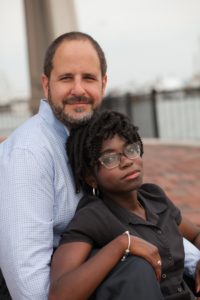The July 2018 issue of our AchievABLE Newsletter contains stories on the following:
- Advocacy Groups Celebrate the ADA by Taking Action to Expand Eligibility for ABLE
- ABLE National Resource Center Named a Semi-finalist in the “Unlocking Change Challenge”
- New Jersey and Washington Become Latest States to Launch ABLE Programs
- The ABLE National Resource Center Partners with the Special Needs Alliance to Help Expand ABLE Education
- ABLE Advisor Profile: Meet Al Elia
- ABLE Advisor Profile: Meet Katy Oliver
- ABLE Advisor Profile: Cheryl Walfall-Flagg
- Webinar Archive: Advantages of ABLE for Those Not Receiving Public Benefits
Advocacy Groups Celebrate the ADA by Taking Action to Expand Eligibility for ABLE
ACTION ALERT: CELEBRATE THE 28th ANNIVERSARY OF THE ADA BY HELPING TO PASS THE ABLE AGE ADJUSTMENT ACT: National Call-in Day – Thursday, July 26, 2018
The Americans with Disabilities Act (ADA) is a landmark civil rights law that prohibits discrimination based on disability. To celebrate the 28th anniversary of its enactment, please take a few minutes to call or email your legislators to ask them to support the ABLE Age Adjustment Act (S.817/HR 1874). This bill would amend Section 529A(e) of the Internal Revenue Code to increase the eligibility for Achieving a Better Life Experience (ABLE) accounts for onset of disability from prior to age 26 to prior to age 46 so that millions more people with disabilities can take advantage of this important savings tool. Despite nearly three decades under ADA law, people with disabilities still regularly encounter discrimination in many aspects of life, including lacking financial opportunities to save for their future and enhance their quality of life. Together we can advocate to #ExpandABLE and pass the #ABLEAgeAdjustment Act.
Background
First introduced in the 114th Congress, the bipartisan ABLE Age Adjustment Act was re-introduced in the 115th Congress by Senators Bob Casey (D-PA), Chris Van Hollen (D-MD) and Richard Burr (R-NC), and Representatives Cathy McMorris Rodgers (R-WA), Pete Sessions (R-TX), Tony Cárdenas (D-CA), Chris Smith (R-NJ), and Jim Langevin (D-RI). The limitation on eligibility based on age of onset of disability did not exist in the original ABLE legislation but was added at the end of the ABLE Act’s nearly ten-year legislative history to reduce the bill’s score and get it over the finish line. This concession resulted in otherwise-eligible individuals with disabilities – many of whom fought for years to get the ABLE Act passed – being prevented from realizing the benefits associated with the ABLE Act based solely on the age at which they became disabled. Nearly 160 other organizations from across the country, believe that ABLE should be expanded to include more people with disabilities, see the letter here: http://www.c-c-d.org/fichiers/CCD-Fin-Sec-TF-and-Allies-Sign-On-Letter-for-ABLE-Age-Adjustment-Act-H.R.1874-S.817-June-22-2018.pdf urging Congress to pass this bill this session.
Beyond the fairness/equity argument for increasing the age of onset, it has now become a financial imperative to pass the ABLE Age Adjustment Act. There are currently thirty-eight states with ABLE programs, yet data collected by the National Association of State Treasurers (NAST) shows that the number of ABLE accounts being opened is much lower than anticipated. The long-term sustainability, availability, and affordability of some ABLE programs for individuals with disabilities are in doubt without this expansion of eligibility (See https://nast.org/wp-content/uploads/2018/05/ABLE_Sustainability-Report_FINAL_04-09-18.pdf_ for the NAST Sustainability Report).
TAKE ACTION
Ask your Senators and Representatives to support people with disabilities and their families by cosponsoring the bipartisan ABLE Age Adjustment Act (S. 817/ HR 1874). Expanding the age of onset is the right thing to do and will give more than 6 million additional people with disabilities access to this important savings tool that enables them to accumulate more than $2000 in assets without jeopardizing their benefits. Whether or not you are currently eligible for an ABLE account, we all have a stake in ensuring the success of ABLE programs so that they are sustainable and so that costs for all ABLE account owners are kept low.
Please contact your congressional members and ask them to cosponsor the ABLE Age Adjustment Act today!
To find your Senators go here: https://www.senate.gov/general/contact_information/senators_cfm.cfm
To find your House of Representatives members go here: https://www.house.gov/representatives/find-your-representative
TALKING POINTS
- I am your constituent from [name of city and state].
- I am calling to ask Senator/Representative [NAME] to cosponsor the ABLE Age Adjustment Act (S. 817/ HR 1874).
- ABLE accounts are important to people with disabilities because they allow them the opportunity to save more than $2000 in assets -to be spent on disability-related expenses – without jeopardizing their much-needed public benefits like Supplemental Security Income (SSI) and Medicaid.
- Unfortunately, only people whose disabilities occurred prior to age 26 are currently eligible for ABLE accounts.
- By increasing age of onset from before age 26 to before age 46, this bill will enable at least 6 million more people with disabilities to open an ABLE account and enhance their financial independence and quality of life.
- It will also increase the likelihood that ABLE programs across the country will be sustainable and costs will be kept low.
- I hope we can count on Senator/Representative [NAME] to support the disability community and cosponsor the ABLE Age Adjustment Act!
ABLE National Resource Center Named a Semi-finalist in the “Unlocking Change Challenge”
The ABLE National Resource Center is proud to announce that we have been named as a Semi-Finalist in the nation-wide “Unlocking Change Challenge”, sponsored through the collaboration of BNY Mellon and Ashoka.
Ashoka and BNY Mellon have searched the United States for innovations that actively increase financial wellbeing for communities and individuals who need it most. Their aim is to uncover and identify ideas, programs, and organizations founded by visionary entrepreneurs, rooted in the needs and solutions from communities across the country.
Out of more than 100 innovators who submitted their ideas to the Challenge, The ABLE National Resource Center was announced as one of the 37 “Drivers of Financial Wellbeing”–a set of semifinalists from nearly 40 states across the country whose bold ideas are creating a strong financial future for individuals and families.
The 10 finalists will be announced in late August, followed by the announcement of the 4 winners in October. The 4 winners of the Challenge will receive $50,000 which will go toward furthering their goal of impacting the financial well-being of underserved communities.
New Jersey and Washington Become Latest States to Launch ABLE Programs
The ABLE National Resource Center, managed by National Disability Institute (NDI), is excited to congratulate the States of New Jersey and Washington on being the most recent states to launch ABLE programs. The New Jersey ABLE program, named “NJ ABLE”, is a member of the National ABLE Alliance, and will be administered by the New Jersey Department of Human Services and managed by Ascensus College Savings Recordkeeping Services, LLC.
The Washington State ABLE Savings Plan (Washington State ABLE) will be managed by BNY Mellon, through their Sumday Administration, LLC platform. NJ ABLE Accounts will offer enrollment to all ABLE-eligible individuals regardless of residency while Washington State ABLE will be available to eligible Washington State residents with disabilities.
Both NJ ABLE and Washington State ABLE allow qualified individuals with disabilities to save up to $15,000 a year in an ABLE account without jeopardizing their eligibility for federally-funded means-tested benefits, such as Supplemental Security Income (SSI) and Medicaid. The funds in these accounts can be used for disability-related expenses that assist the beneficiary in increasing and/or maintaining his or her health, independence or quality of life.
Like other ABLE programs across the country, the NJ ABLE and Washington State ABLE programs focus their efforts to ensure minimal costs associated with establishing and maintaining an ABLE account (which can be completed online). The NJ ABLE program has annual account fees of $45 for electronic statements or $60 for paper statements, payable quarterly. Fees associated with investment options range from 0.34% – 0.38%. Until June 30, 2019, the Washington State ABLE Savings Plan annual account fee will be waived for all those who remain Washington State residents. After this date, the annual cost will be $35 with an additional $10 fee for paper statements. Fees associated with investment options for these accounts range from 0.30% – 0.3702%
For more information on the NJ ABLE program and how to enroll, please visit https://savewithable.com/nj/home.html.
For more information on the Washington State ABLE Savings Plan and how to enroll, please visit https://www.washingtonstateable.com/.
The ABLE National Resource Center Partners with the Special Needs Alliance to Help Expand ABLE Education
The Special Needs Alliance (SNA) and ABLE National Resource Center (ANRC) have agreed to collaborate on efforts to educate individuals with disabilities, their families and other stakeholders on how ABLE accounts and special needs trusts (SNTs) can contribute to improved quality of life. Funds held in either instrument, if properly used, are not considered countable resources by means-tested government programs such as Medicaid and Supplemental Security Income (SSI), which often form the foundation for special needs planning. ABLE accounts and SNTs can supplement those benefits without affecting an individual’s eligibility for them.
The creation of state-run ABLE programs was authorized by the U.S. Congress through the Achieving a Better Life Experience Act of 2014. A notable advantage of ABLE accounts is that they can be managed by individuals with disabilities themselves, while SNTs must be administered by a trustee. On the other hand, ABLE accounts have annual contribution caps, while SNTs do not. Awareness-building will take the form of articles, white papers, webinars and conference participation.
“The ABLE accounts and SNTs are governed by very different rules, which has been confusing,” notes SNA President Brian N. Rubin. “On a daily basis, our member attorneys have been helping individuals and their families determine if one or both would best serve their needs.”
“ABLE accounts are a great way to increase the independence of individuals with disabilities and move them more into the financial mainstream,” says Michael Morris, Director of the National Disability Institute, which founded and manages ANRC. “We want to increase public awareness of how these tools can benefit them.”
The Special Needs Alliance is a national organization comprised of attorneys committed to helping individuals with disabilities, their families and the professionals who serve them with special needs planning. ANRC is a collaborative that brings together the investment, support and resources of some of the country’s largest, most influential national disability organizations in an effort to accelerate the design and availability of ABLE accounts and to educate stakeholders on ABLE’s potential positive impact on the lives of millions of Americans with disabilities.
ABLE Advisor Profile: Meet Al Elia
 Al Elia, a Harvard graduate and disability rights attorney, who lives and works in Washington D.C. with his wife Marlie, might not be someone you think of when you think of an ABLE account holder.
Al Elia, a Harvard graduate and disability rights attorney, who lives and works in Washington D.C. with his wife Marlie, might not be someone you think of when you think of an ABLE account holder.
The most common reason eligible individuals with disabilities and their families open an ABLE account is to have the ability to save and invest money above the $2,000 asset limit of Supplemental Security Income (SSI), Medicaid and other Social Security programs. As a result of his employment earnings, however, Al isn’t on public benefits.
Still, due to his blindness, and its onset prior to the age of 26, Al is ABLE eligible and chose to become an ABLE account owner with the Massachusetts AttainABLE program in 2017.
So why would a successful lawyer, Harvard graduate and participant in the economic mainstream set up an ABLE account?
Al became an ABLE account owner to have a tax-advantaged means of saving for retirement. Al notes that his ABLE account has an additional benefit compared with other retirement vehicles: He can access the funds in his ABLE account at any point for major life expenditures without incurring early withdrawal fees.
Because his employer does not have the resources to offer retirement benefits, Al may contribute up to an additional $12,060 per year from his earnings as ABLE savings above the $15,000 annual ABLE contribution limit.
As an ABLE Advisor, Al personifies the Advantages of ABLE for Those Not Receiving Public Benefits and was featured as a panelist during ABLE NRC’s June 2018 webinar.
Al says, “If you qualify for an ABLE account, an ABLE account is going to be useful to you. It’s not just for kids. It’s not just for people with severe disabilities that may preclude them from working. The ABLE Account will benefit you if you take the time to set one up.”
ABLE Advisor Profile: Meet Katy Oliver
 Katy Oliver, who is 28 and works full time for a company that does clinical trials for drug companies, is also on the Medicaid Buy-In Program. She registered for her ABLE account through Ohio’s ABLE program, the first ABLE program in the United States, in June 2016.
Katy Oliver, who is 28 and works full time for a company that does clinical trials for drug companies, is also on the Medicaid Buy-In Program. She registered for her ABLE account through Ohio’s ABLE program, the first ABLE program in the United States, in June 2016.
Katy and her husband, Brandon, live in Texas. Although Texas launched their ABLE program this year, Katy plans on keeping her Ohio ABLE account because their debit card option makes it easier for her to access her ABLE funds. A savvy account owner, Katy uses the comparison tool and webinar trainings on the ABLE NRC website to guide her in making these kinds of decisions.
Katy’s short-term goal is to use her ABLE funds to purchase a customized cover for her power-assist wheelchair, which isn’t covered by insurance but will prevent damage during travel. Her long-term goal is to design and build her dream HGTV quality, wheelchair accessible home.
In addition to her ABLE account, Katy has a Special Needs Trust which her husband oversees as her rep payee. Her grandparents are including Katy in their estate planning and a bulk inheritance will likely exceed her ABLE annual limit. ABLE NRC resources will assist Katy as she continues to explore the intersections between her ABLE funds, Special Needs Trust and Medicaid Buy-In.
As an ABLE Advisor, Katy wants other ABLE-eligible individuals and their families to know that “The process of getting an ABLE account is pretty painless. It seems counterintuitive to everything we have been told. I’m a living, breathing example that this does not count against you. I’m getting the same services as before. It doesn’t count against you and, unlike a trust, it isn’t expensive.”
ABLE Advisor Profile: Meet Cheryl Walfall-Flagg
 Cheryl Walfall-Flagg is the mother of Sean, a 16-year-old ABLE account owner and budding artist. Cheryl and her husband, Terence, have another son, Terrell (18), and her husband’s nephew, Davante (11), for whom they are both legal guardians. The Flagg family set up Sean’s ABLE account in their home state of North Carolina. As part of her work at the Orange County Early Head Start program, and as a parent advocate, Cheryl engages in multiple parent resource groups where she shares information about ABLE and its benefits.
Cheryl Walfall-Flagg is the mother of Sean, a 16-year-old ABLE account owner and budding artist. Cheryl and her husband, Terence, have another son, Terrell (18), and her husband’s nephew, Davante (11), for whom they are both legal guardians. The Flagg family set up Sean’s ABLE account in their home state of North Carolina. As part of her work at the Orange County Early Head Start program, and as a parent advocate, Cheryl engages in multiple parent resource groups where she shares information about ABLE and its benefits.
A key part of Cheryl’s ABLE strategy has been the decision to contribute a set amount to Sean’s ABLE Account on a quarterly basis instead of on a monthly basis. This approach allows flexibility for those months where her family might not have funds to contribute.
Cheryl contemplated using ABLE funds to pay activity fees for a social club that Sean, who is on the Autism spectrum, participates in. Cheryl realized that paying for a monthly activity out of the ABLE account undermined their longer-term goals and bigger ticket items that could be secured by these funds, such as college for Sean. As a result, the Flaggs use ABLE as a savings and investment account instead of a checking account.
As an ABLE Advisor, Cheryl wants other parents of ABLE-eligible youth to know that “The first thing to know is that the account is easy to set up. I’m not a financial or a mathematical person. I’m just a mother looking out for her son’s future. The other thing is to start to plan sooner than later. Many parents are so consumed with their child’s disability issues and are in survival mode – trying to figure those day-to-day things out, we have to take that one step back. Do that piece of financial planning for the future. The ABLE account is one easy, simple way to get that done. It is one simple thing you can do.”
Webinar Archive: Advantages of ABLE for Those Not Receiving Public Benefits
A recording of June’s webinar, “Advantages of ABLE for Those Not Receiving Public Benefits,” is now available.
